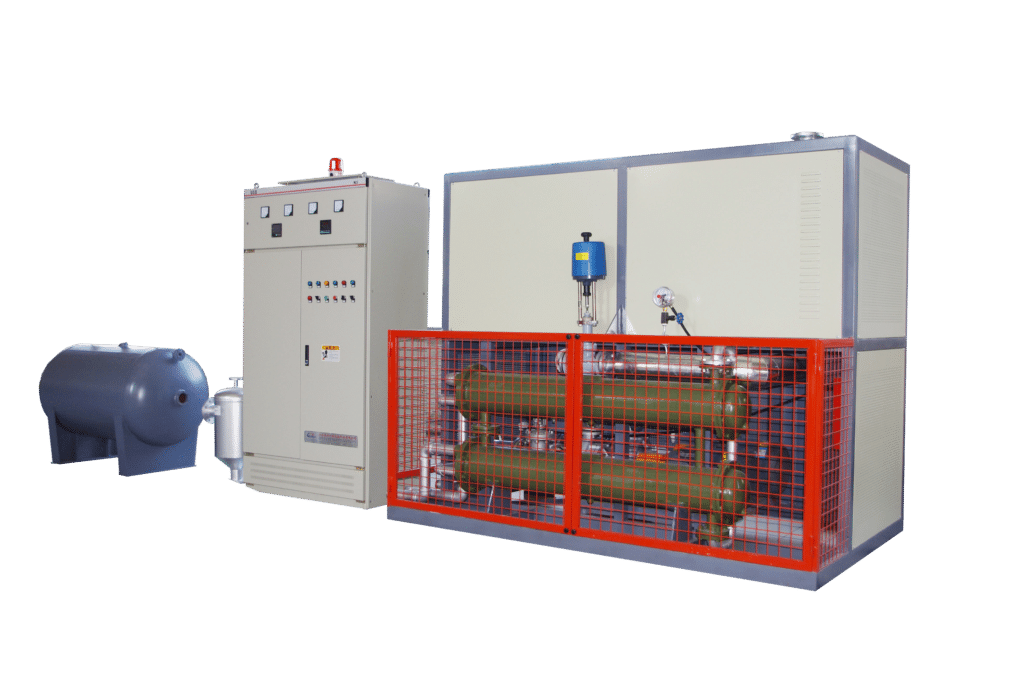Electric thermal fluid heatershttps://8ruiyan.com/en/all-organic-heat-carrier-boilers/, as energy-efficient industrial thermal equipment, are widely used in industries such as chemical processing, pharmaceuticals, food processing, rubber and plastics, building materials, and more. As industrial production demands increasingly stable heat sources, many users are concerned about whether electric thermal fluid heaters are suitable for long-term continuous operation, particularly regarding equipment stability and safety under high-load, high-temperature conditions.

I. Design Features and Applicability of Electric Thermal Fluid Heaters
The core principle of an electric thermal fluid heater is the conversion of electrical energy into thermal energy via electric heating elements. The heated thermal fluid is then circulated to process equipment via a pumping system to transfer heat. The design focuses on several key aspects:
- High Efficiency: Direct heating by electric elements achieves thermal efficiency exceeding 95%.
- Precise Temperature Control: Equipped with advanced temperature control systems for minimal temperature fluctuation, meeting precise process requirements.
- High Safety: Incorporates multiple safety protection devices such as overtemperature protection, pressure protection, and pressure relief devices.
- Compact Structure: Small footprint, flexible installation, suitable for diverse working conditions.
- Environmentally Friendly & Pollution-Free: No combustion process, no exhaust emissions.
These design features make electric thermal fluid heaters highly suitable for production environments requiring stable heat sources and inherently capable of continuous operation.
II. Thermophysical Properties of Heat Transfer Fluid and Their Impact on Continuous Operation
The thermal fluid, acting as the heat transfer medium, dictates the stability and safety of the system operation. Commonly used thermal fluids possess the following characteristics:
- Broad Operating Temperature Range: Typically withstands temperatures above 320°C.
- Strong Thermal Stability: Resists decomposition within the designed temperature range.
- Good Fluidity: Ensures smooth circulation.
- Low Vapor Pressure: Minimizes system leakage and evaporation losses.
Long-term continuous operation imposes higher demands on the thermal fluid. The fluid must maintain thermal stability, avoiding excessive formation of deposits that could clog piping and reduce heat exchange efficiency. Regular maintenance and fluid analysis are critical to ensuring optimal fluid condition.
III. Technical Safeguards for Long-Term Continuous Operation of Electric Thermal Fluid Heaters
- Durable Equipment Design:
- High-quality electric heating elements, high-temperature resistant sealing materials, and robust piping systems form the foundation for long-term stable operation.
- Design must account for thermal expansion, vibration, and long-term thermal stress. Proper component selection and structural layout ensure resistance to damage.
- Intelligent Control System:
- Modern heaters feature PLC control systems that monitor key parameters (temperature, pressure, current) in real-time.
- Automatic power adjustment prevents overtemperature or overload.
- Fault diagnosis and alarm functions facilitate early detection of abnormalities, preventing equipment damage.
- Stable Circulation System:
- Pumps must be correctly sized to ensure stable fluid velocity and pressure.
- Scientific pipe layout avoids dead legs and air pockets.
- Systems include expansion tanks and safety valves to accommodate thermal expansion/contraction and pressure fluctuations.
IV. Potential Issues During Long-Term Continuous Operation and Solutions
- Thermal Fluid Degradation:
- Problem: Continuous high-temperature operation accelerates oxidation and thermal cracking, forming sludge and carbon deposits, impacting system performance.
- Solutions:
- Regularly test fluid properties (acid number, viscosity, flash point, contamination).
- Replace fluid promptly based on analysis results.
- Strictly control operating temperature within the fluid’s thermal stability limit.
- Electric Heating Element Failure:
- Problem: Prolonged full-load operation can cause element overload, aging, leading to breakage or short circuits.
- Solutions:
- Use elements made from high-temperature and corrosion-resistant materials.
- Periodically check resistance and insulation performance.
- Avoid frequent start/stop cycles; maintain steady operation.
- Circulation Pump Failure:
- Problem: Mechanical wear and bearing failure disrupt fluid circulation.
- Solutions:
- Perform regular lubrication maintenance.
- Monitor pump vibration and noise.
- Maintain a standby pump for rapid switching during failures.
- System Safety Hazards:
- Problem: Risks include abnormal pressure, excessive temperature, and fluid leaks.
- Solutions:
- Install multiple safety devices (safety valves, pressure gauges, temperature sensors, emergency stop buttons).
- Ensure operators strictly adhere to procedures and receive regular training.
- Develop and practice emergency response plans.
V. Practical Application Cases of Continuous Operation
Numerous industries successfully utilize electric thermal fluid heaters for 24/7 heating:
- Chemical Industry: Providing stable heat to reactors and distillation columns.
- Food Processing: Continuous heating of oils, syrups, etc., maintaining production line continuity.
- Rubber & Plastics Processing: Maintaining consistent mold temperatures to ensure product quality.
These cases demonstrate that properly designed and maintained electric thermal fluid heaters can fully meet long-term continuous operation demands, enhancing production efficiency and equipment utilization.
VI. Key Maintenance Points for Long-Term Continuous Operation
Ensuring long-term stability requires diligent maintenance:
- Regular Fluid Testing & Replacement: Maintain fluid performance, prevent coking and blockages.
- Routine Equipment Inspection: Check heating elements, pumps, valves, and safety devices; address potential issues promptly.
- System Cleaning: Periodically clean fluid circuits and heat exchangers to remove sludge and deposits hindering heat transfer.
- Temperature Control Optimization: Adjust setpoints based on process needs; avoid overtemperature and excessive cycling.
- Personnel Training: Enhance operators’ equipment management and troubleshooting capabilities.
VII. Conclusion
Electric thermal fluid heaters, with their sound design and control systems, are capable of meeting long-term continuous operation requirements. Through appropriate equipment selection, scientific operational management, and strict maintenance, equipment lifespan can be extended, ensuring system stability and safety.
For further consultation, please contact our technical team for expert advice.
Whatsapp:86-19106101570
wechat:86-19106101570
email:nieyili@cnryan.com
